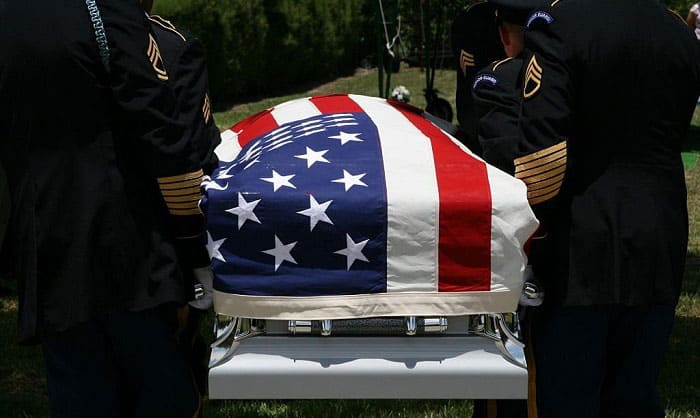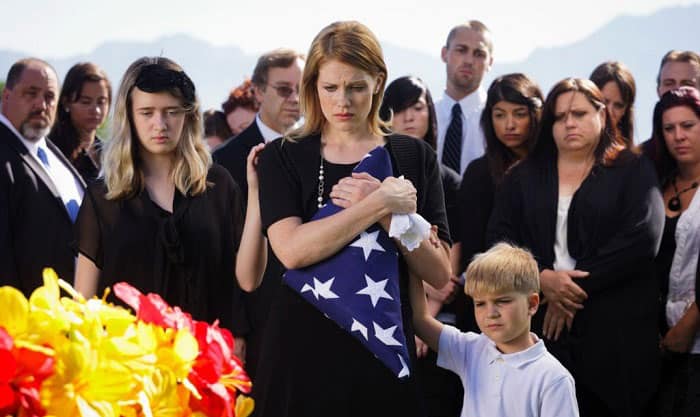
Like other military ceremonies, it is incredibly crucial that you know how to act appropriately at a military funeral. If you are about to attend one yourself, you will find the information in this article very helpful. All the essentials on military funeral etiquette are curated here.
We will answer 4 key questions, which are the most common among military funeral attendees:
- When to salute at a military funeral?
- What to wear to a military funeral?
- Who gets the flag at a military funeral?
- What to say at a military funeral?
In answering the above questions, we will cover everything you might want to know about this topic of military funeral protocols. Therefore, make sure you do not stop reading until you reach the end!
Table of Contents
Military Funerals 101

When to salute at a military funeral?
To answer this question, we will first brief through the military funeral procedure. Here are the sequence of events:
- The funeral coach or caisson comes to the gravesite.
- The military members render a salute.
- The casket crew lifts the casket while the officer in charge, non-commissioned officer in charge and chaplain render a salute.
- The chaplain leads the casket team into the gravesite.
- The casket team puts the casket down and secures the flag.
- The OIC/NCOIC check that the flag is stretched, leveled, and centered over the casket.
- The family members of the deceased are seated.
- The chaplain performs the service.
- The OIC/NCOIC steps up to the casks after the service is concluded.
- The family members rise for honors upon the gravesite’s representative.
- The OIC/NCOIC initiates the rifle volley by presenting arms.
- The bugler plays Taps and the family sits back down.
- The flag folding ceremony is held, and once completed is passed to the OIC/NCOIC.
- The flag is presented to the deceased’s next of kin.
- Condolences are extended before the service concludes.
As you have read, it is necessary to salute when the funeral coach/caisson arrives, and when the casket is lifted by the casket crew. Other than that, military members should do military funeral salute when:
- the hearse is in front of them
- the casket with the flag draped over it is moved
- the formal gun salute is happening
- when Taps is played
- when the casket is lowered into the ground
Now that we know when to salute, let’s move onto who should salute. All military members and former military members, even not in uniform, may salute; however, civilians shout not. Instead, civilians should remove their head gear and place it over their heart to show respect. If they are not wearing any head gear, they can still place their right hand over their heart.
Speaking of head gear, you may want to know what to wear to a military funeral. The following section will give you some guidance.
What to wear to a military funeral?
The number one priority is respect. All attendees should be dressed respectfully. Both military members and civilians should avoid casual clothes, such as T-shirts, jeans, and sweaters.
- Funeral etiquette for wearing a military uniform
The latter (military personnel) should be dressed in their uniform (Class – A) or dress uniform. It is not appropriate to wear a battle dress. Also, make sure that your uniform has all the decorations, badges, medals, ribbons, and insignia. You do not have to wear white gloves unless there are set instructions by your installation or commanding officer. It is also optional to add a brassard — a straight, 2-inch x 4-inch plain black band to the left sleeve, between the elbow and the shoulder.
Note: If you are an active personnel, it is best to follow the commanding officer’s directive. Adversely, If you are a retired servicemen/women, you may wear uniforms with the insignias and rank that you held when you retired.
While the former (civilians) should be in formal mourning attire, it is best to stick to dark colors. For men, suits are recommended. Otherwise, a dress shirt, slacks, and a tie.
On the other hand, women are expected to wear a suit, dress, or combination of skirt and blouse. As for footwear, be sure to wear something that looks nice and is comfortable at the same time. You can wear some accessories, but avoid bangle bracelets and necklaces that can make a lot of noise.
Note: A good tip is to dress as if you are going to a traditional church service.
Who gets the flag at a military funeral?
As mentioned earlier in the first section, the military flag is presented to the next of kin, who is the most closely related person to the deceased. The recipient of the flag can preserve it in their house for display. Usually, it is framed and hung up on a wall. But there is also an option to donate it for national veteran events.
The next of kin is appointed by the veterans themselves before their deployment. However, if the next of kin passes away before that, the next of kin’s next of kin will be the flag recipient. If they are not available to receive the flag, the order of succession for the recipient are
- spouse
- children (by age)
- parent or guardian (by age)
- adopted relative with granted legal custody
- grandparent (by age)
Note: By age means the oldest to the youngest
The next of kin gets to keep the flag for life. They can pass it onto or give it away to anyone they want. When the next of kin dies, the flag will still legally belong to the next of kin.
You also can check this post to see more details!
What to say at a military funeral?
There will be specific times to speak at a military funeral. The most notable is when the flag is presented to the next of kin by the chaplain. The chaplain will say, “As a representative of the US military, it is my high privilege to present to you this flag,” along with condolences. They might also say, “Let this flag be a symbol of the appreciation this country feels for the service rendered and to our flag by your loved one.”
If you want to send your own condolences to the family members of the deceased, here are some things you can consider saying:
- Your son/daughter is truly a hero. He/she bestowed honor to the uniform he/she wore, and the sacrifice he/she made for what he believed shall forever be remembered.
- The loss of your son/daughter was not in vain. He/she gave the ultimate sacrifice. That makes him/her nothing less than a hero, and he/she will always be remembered that way.
- Your son/daughter is a true patriot and gave his/her life in service to his country. No greater sacrifice can be made nor demonstration of courage needed. He/she will always be our hero.
- Our country owes a huge debt to your son/daughter for his/her service. He/she will surely be missed. My heartfelt condolences.
Conclusion
Great! You now have detailed information on military funeral etiquette. We hope that what you have read here will help you in your next military funeral attendance.
If you have any other questions to ask or thoughts to share on this topic, please leave them with us in the comments. We would be glad to hear your input. Please help us share this with other readers, such as your friends and family members, as well.

I am Everett Bledsoe, taking on the responsibility of content producer for The Soldiers Project. My purpose in this project is to give honest reviews on the gear utilized and tested over time. Of course, you cannot go wrong when checking out our package of information and guide, too, as they come from reliable sources and years of experience.
